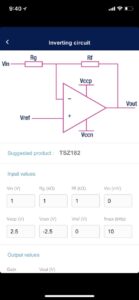ST op-amps (for iOS and Android) is the first mobile app that guides engineers in their search for the right operational amplifier (op amp) while also offering a cross-reference feature to find ST alternatives to competing devices. Op amps are one of the fundamental building blocks of an analog circuit as they amplify a signal without compromising it with significant interference. As a result, we find them in many different settings, such as a hardware unit for arithmetic computation (add, subtract, etc.) or to guarantee a host microcontroller (MCU) can process the data from a low power sensor. Although they can sometimes be overlooked, op amps play a crucial role in a design’s performance, and choosing the right component, like the TSU111, the most precise nano-power operational amplifier, can have enormous consequences on the battery life of the final product, for instance.
As a result, ST op-amps is much more than a simple app cataloging devices, but a way to keep engineers and enthusiasts abreast of the latest developments and releases, thanks to its news section accessible straight from its home screen. Furthermore, the application also downloads its content on the mobile device after its first launch so users can still enjoy it offline regardless of where and when they need a particular information that will be crucial to finishing a design. Indeed, ST op-amps is a great companion. Its “Product Selector,” “Schematics,” “Technical information,” and “Cross reference” features are powerful, and although it’s impossible to explain in detail everything this rich application offers, let’s look at the reasons that make it so much more than just an op amp app.
Reason 1: It’s Also a Curator and Flexible Search Engine

One of the strengths of the ST op-amps app is that its “Product selector” recognizes that engineers may not actually need an operational amplifier per se, but a derivative of its architecture, which is why users first get a list of categories (see screenshot on the right). Hence, designers looking to compare a voltage to a specific threshold (for protection concerns, such as over-temperature or under-voltage detection) will find what they need in the “Comparators” category. Similarly, teams building a circuit that must measure an electrical current don’t need to scroll through hundreds of choices since they can go straight to the “Current sensing” section. Ultimately, ST curated the experience to guide engineers toward the optimal solution for their design.
Enthusiasts that require a typical operational amplifier will still have to sort through almost three hundred devices, which can be daunting. As a result, ST op-amps also offers one of the most comprehensive parametric search engines for such an application, with up to 18 different filters. Naturally, engineers won’t fill them all up when searching for a component, but this vast array of choices keeps the app flexible. For example, engineers at a car maker working on a circuit that carries a sensor’s signal to the host MCU would be at a loss if they couldn’t select “Autograde,” then chose a small VIO value to guarantee a really high precision. By offering such an extensive selection of parameters, we planned for an immense array of scenarios, ensuring that our app stays relevant and that most engineers can find the few filters they need for their use-case.
Reason 2: It’s Also a Communication and Teaching Tool

The structure of ST op-amps also makes it a great communication tool so engineering teams can relate to decision makers that may not always have an advanced grasp of all the technical minutiae of a particular design. Hence, the major categories of the “Product Selector” act as an icebreaker that can direct the conversation to more appropriate solutions. Similarly, with so many parameters, people can express in layman’s terms what they are looking for and designers can translate that into specifications that will ensure everyone knows what they are getting and what to expect.
Moreover, those that wish to go even deeper in the technical aspects of a device can download its datasheet straight from the app. We must note, however, that this type of document is not part of the offline content and requires an Internet connection. However, once downloaded, the app stores it on the device for offline and easy retrieval. Users wishing to free up space can go to “Settings” and click on “Free memory”.
ST op-amps also speaks to engineers thanks to its invaluable “Schematics” category that acts as a calculator and a lookup tool for the most common circuits and mathematical formulas needed when designing for an operational amplifier. Similarly, the “Technical information” category offers important tips, definitions, and reminders to assist enthusiasts or students. The application is thus a pedagogical tool and a way to select an op amp according to a specific application. For instance, in “Schematics” users choose a type of circuit, enter its basic values, and the application not only handles major computations but also suggests a pertinent device.
Reason 3: It’s Also a Path to Excellence

In fact, the ST op-amps app shines most unexpectedly through its “Cross reference” section, because this feature enables users to check out a component’s main alternatives, regardless of the manufacturer. Indeed, the feature, often overlooked because quite unusual, is fundamental as engineers don’t always question their choices in operational amplifiers, often relying on past solutions. However, if they search for competing devices, the “Cross reference” feature will automatically display the alternative solutions from ST with a table comparing their significant specifications. Ergo, teams will either be confident that they made the right choice or they will see how they can improve their design. Ultimately, the app isn’t merely a way to help us put our products forward, but a tool to support the engineering and enthusiast community.
If users choose to go with an ST component, a bar called “Sample and buy,” at the bottom of each product page, will guide them through purchasing the device at one of the leading channel partners, so they can quickly start working with it. After all, it’s easy to dismiss operational amplifiers because of their perceived commoditization. However, as we found out, the right one can propel performance, and inversely the wrong one can produce catastrophic results. This is why the app ST op-amps tries to lower the barrier of entry and bring people together around a conversation on the most appropriate operational amplifier for a design so everyone can take pride in what they built, all the way down to the last detail. Let us know in the comments section below what you think of ST op-amps and what features you’d like to see.
